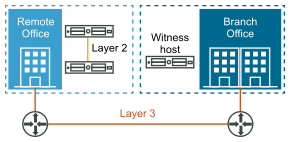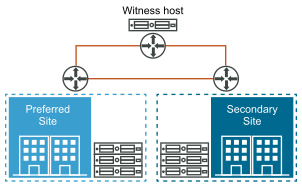This section covers the different supported deployment options that are supported for vSAN clusters.
Standard vSAN Cluster
A standard vSAN cluster consists of a minimum of three hosts. Typically, all hosts in a standard vSAN cluster reside at the same location, and are connected on the same Layer 2 network. All-flash configurations require 10 Gb network connections, and this also is recommended for hybrid configurations.
For more information, see Creating a vSAN Cluster.

Two-Node vSAN Cluster
Two-node vSAN clusters are often used for remote office/branch office environments, typically running a small number of workloads that require high availability. A two-node vSAN cluster consists of two hosts at the same location, connected to the same network switch or directly connected. You can configure a two-node vSAN cluster that uses a third host as a witness, which can be located remotely from the branch office. Usually the witness resides at the main site, along with the vCenter Server.
For more information, see Introduction to Stretched Clusters.

vSAN Stretched Cluster
A vSAN stretched cluster provides resiliency against the loss of an entire site. The hosts in a stretched cluster are distributed evenly across two sites. The two sites must have a network latency of no more than five milliseconds (5 ms). A vSAN witness host resides at a third site to provide the witness function. The witness also acts as tie-breaker in scenarios where a network partition occurs between the two data sites. Only metadata such as witness components is stored on the witness.
For more information, see Introduction to Stretched Clusters.
